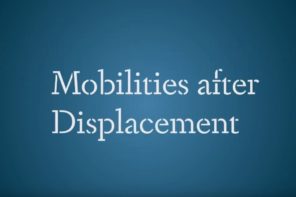Hilary Charlesworth is a Professor of International Law and Human Rights at the Australian National University. She is also an Australian Research Council Laureate Fellow and Director of the Centre for International Governance and Justice. Emma Larking is an Australian Research Council Laureate Postdoctoral Fellow at the ANU’s Centre for International Governance and Justice. Allegra met them for a ‘virtual conversation’ on their new edited volume: Human Rights and the Universal Periodic Review: Rituals and Ritualism, published with Cambridge University Press late last year.

C&L: The most distinctive feature of the UPR is the fact that it is a mechanism that reviews all 193 members of the UN. This takes place over a four and half year cycle. In this way, the UPR undermines the common belief, particularly in the West, that there are human rights ‘good guys’ and ‘bad guys’. What is also striking is that, so far, no country has refused to participate in the UPR. Israel did express doubts about the second UPR cycle, but, in the end, agreed to submit itself to UPR scrutiny. Other human rights monitoring mechanisms, such as that by the treaty bodies, apply only to states that have accepted particular treaties.
Another important aspect of the UPR is that it is a system of peer-review in the sense that it is review by states of each other. Many of the contributors to this book observe that states tend to take this form of scrutiny much more seriously than that of human rights bodies consisting of experts, such as the treaty bodies. Indeed, there have been concerns expressed that the UPR may undermine expert forms of review.
The UPR requires each state to submit a report on the protection of human rights. Material is also gathered from non-state sources, such as the special procedures and national human rights institutions. The Office of the High Commissioner for Human Rights also compiles information from civil society. The next stage is the ‘interactive dialogue’ in which the state under review presents its report to the HRC and receives questions from other states. Following the interactive dialogue, the HRC prepares an ‘outcome report.’ The outcome report is designed to summarise the dialogue and reflects the questions, comments and recommendations put to the state under review, as well as the state’s responses. It identifies recommendations that ‘enjoy the support’ of the state under review, and notes those recommendations that the state does not support, along with the state’s comments. The reviewed state then is responsible for implementing the recommendations it has accepted, and of reporting during subsequent periodic reviews on the progress of implementation, as well as more broadly on its human rights situation.
So, the UPR is a process that gives states a fair degree of discretion, but allows a regular monitoring of how they have delivered on their commitments.
Allegra: The choice of contributors for this volume is quite eclectic. Beside legal scholarsand anthropologists, human rights activists and NGOs’ representatives have also given their contribution. What was your main objective in putting this edited volume together?
C&L: We were conscious that the legal literature on human rights institutions tended to be more interested in formal procedures than on what actually happened on the ground. Given that the UPR is in its infancy, we were keen to draw together many different perspectives on how the UPR is working. We think that anthropologists have a particularly rich frame of analysis on international institutions, paying regard to the behaviour of the people who make the UPR work. They emphasise that the international arena has its own cultures.
Allegra: The main frame of analysis you use to describe the multifarious effects of the UPR is the one inspired from the legal literature on ‘regulation’. Why do you find such a theoretical framework particularly well suited to explain the UPR?
C&L: Our interest in regulation is inspired by our academic home in the Regulatory Institutions Network here at the ANU. RegNet was established to study regulation in all its forms and our colleagues include sociologists, criminologists, psychologists as well as lawyers. The idea of regulation is understood very broadly – as influencing the course of events. This means that regulation goes far beyond the law, and includes modes of influence such as shaming and peer-pressure. So we approached the UPR with the question ‘How does the UPR regulate?’, or how does the UPR influence the course of events and the observation of human rights. Our goal is not to declare the UPR a good or a bad or a failed mechanism, but rather to investigate how it operates.
Allegra: For most anthropologists familiar with the study of global bureaucracies, the ritualistic dimension of the UPR is quite obvious. However, you argue that if the UPR ritual aims to foster consensus, its repetitive and highly technical nature can easily make it fall into ‘ritualism’. What is ‘ritualism’ exactly about? Should ‘ritualism’ be automatically understood as a form of ‘failure’?
C&L: We have borrowed the idea of ritualism from the writings of the sociologist Robert Merton. In Social Theory and Social Structure (New York: Free Press, 1968), Merton identified five modes of individual adaptation to cultural values: conformity, innovation, ritualism, retreatism and rebellion. These modes also appear at the level of organisations and among collectivities. All five modes are evident in responses to international human rights regulation, but ritualism is particularly pervasive. It has been usefully elaborated by our colleagues John and Valerie Brathwaite as ‘acceptance of institutionalised means for securing regulatory goals while losing all focus on achieving the goals or outcomes themselves’. In the context of the UPR, ritualism can mean participation in the process of reports and meetings, but an indifference to or even reluctance about increasing the protection of human rights. Ritualism is not necessarily exactly the same thing as failure.
It is possible that the mere fact of acceptance of a normative order can shape a state’s behavior, even if its original intentions were not consistent with human rights goals. Being subject to regular and transparent reporting requirements and thus being required to give a public accounting of how states have responded to their obligations – can affect a state’s actions.
Allegra: In recent years, a number of books have been published, all quite pessimistic in tone and announcing ‘the end of human rights’. I am thinking of Lori Allen’s ‘The Rise and Fall of Human Rights’, Stephen Hopgood’s ‘Endtimes of Human Rights’, Samuel Moyn’s ‘The Last Utopia’ and Costas Douzinas’ ‘The End of Human Rights’ . Do you share such a dark vision? Is the UPR the last (and perhaps hopeless) attempt to ‘save human rights’? Or on the contrary, should the UPR be considered as a sign of their increased relevance in the world?
C&L: In our view, the idea that human rights have run their course or can be ‘saved’ from irrelevance misunderstands the role that human rights play. In one sense, of course, the grand promises of the international human rights canon can never be fully realised. The adherence to human rights norms will always be imperfect. But it is possible in particular contexts to harness the transcendent ideals of the international human rights system to press for political and social change. Sally Engle Merry has shown this powerfully in her study of the way that the Convention on the Elimination of All Forms of Discrimination against Women affects behaviour, in Human Rights and Gender Violence (University of Chicago Press 2006). We need to study and understand the power of universalism on which human rights standards are based while also being attuned to the way that human rights can be appropriated at local levels.











